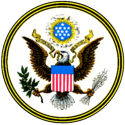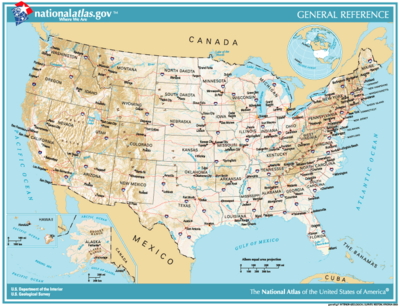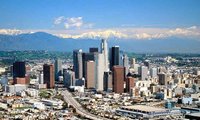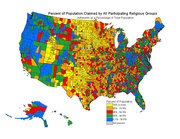You did it! Thanks to your generosity we exceeded our fund drive goal by 15%. (details)
United States
From Wikipedia, the free encyclopedia.
- This article is on the country in North America. For other uses, see United States (disambiguation) and US (disambiguation).
The United States of America, also referred to as the United States, U.S.A., U.S., US, America¹, the States, or (archaically) Columbia, is a federal republic of fifty states, mostly in central North America. The U.S. proper has three land borders, two with Canada and one with Mexico, and one territorial waters boundary with Russia. It is otherwise bounded by the Pacific Ocean, the Bering Sea, the Arctic Ocean, and the Atlantic Ocean. Of the 50 states, however, there are two, Alaska and Hawaii, which are neither contiguous with the other forty-eight nor with each other, and the U.S. has also a collection of districts, territories, and possessions around the world. Each of the fifty states has a high level of local autonomy according to the system of federalism. A United States citizen is usually identified as an American¹.
|
|||||
| National motto: National mottos E Pluribus Unum (1776-present) (Latin: Out of Many, One) In God We Trust (1956-present) |
|||||
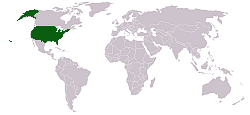 |
|||||
| Official languages | None at federal level; English de facto nationwide |
||||
| Capital | Washington, DC 38° 53′ N 77° 02′ W |
||||
| Largest city | New York City | ||||
| Government | Federal republic George W. Bush Dick Cheney |
||||
| Area - Total - Water (%) |
9,631,419 km² (3rd) 4.87% |
||||
| Population - July 2005 est. - 2000 census - Density |
295,734,134 (3rd) 281,421,906 30/km² (175th) |
||||
| GDP (PPP) - 2003 total - Per capita |
$10,871,095 million (1st) $37,352 (3rd) |
||||
| Currency | US dollar ($) (USD) |
||||
| Time zone - Summer (DST) |
n/a (UTC-5 to -10) n/a (UTCn/a) |
||||
| Independence - Declared - Recognized |
From Great Britain July 4, 1776 September 3, 1783 |
||||
| National anthem | The Star-Spangled Banner | ||||
| Internet TLD | .gov .edu .mil .us .um | ||||
| Calling code | +1 |
||||
The United States traces its national origin to the Declaration (which developed out of the United Colonies of America governed by the Second Continental Congress, formed in 1775) by thirteen British colonies in 1776 that they were free and independent states and they were recognized as such by the Treaty of Paris (1783). The foundation of the nation was laid by the Albany Congress in 1754 during the Seven Years' War (French and Indian War). Since the mid-20th century, it has surpassed all other nations in contemporary economic, political, military, and cultural influence.
The U.S. was founded under a tradition of government based on the consent of the governed under the representative democracy model. The particular form of government of the U.S., (presidential-congressional), has since been adopted by many other countries, mostly in Central America and South America.
| Contents [hide] |
History
Main article: History of the United States
Following the European colonization of the Americas, thirteen colonies split from Britain and formed the United States, one of the world's first modern representative democracies, after their Declaration of Independence in 1776 and the Revolutionary War (1775–1783). The original political structure was a confederation in 1777, ratified in 1781 as the Articles of Confederation. After long debate, this was supplanted by the Constitution in 1789, forming a more centralized federal government.
During the 19th century, many new states were added to the original thirteen as the nation expanded across the North American continent, destroying many Indian nations in a decades-long military campaign, and through coercion, military prowess, and diplomatic leverage, it acquired a number of overseas possessions; during this period the nation became an industrial power. The two major traumatic experiences for the nation were the Civil War (1861-1865) and the Great Depression (1929-1939), and it has taken part in several major wars, from the War of 1812 against Britain, to being allied with Britain during World War I and World War II, and taking part in the Korean and Vietnam Wars. After the end of the second World War and the later collapse of the Soviet Union, the United States emerged as the world's leading economic and military superpower.
See also: Military history of the United States, Timeline of United States history, Timeline of Islamic terrorism against the United States
Politics
Main article: Politics of the United States
The United States of America consists of fifty states with limited autonomy in which federal law takes precedence over state law. In general, matters that lie entirely within state borders are the exclusive concern of state governments, although this constitutional responsibility has been eroded since the Civil War (1861-1865). These include internal communications; regulations relating to property, industry, business, and public utilities; the state criminal code; and working conditions within the state. The District of Columbia falls under the jurisdiction of the US Congress, but has limited home rule.
The various state constitutions differ in some details but generally follow a pattern similar to that of the federal Constitution, including a statement of the rights of the people and a plan for organizing the government. On such matters as the operation of businesses, banks, public utilities and charitable institutions, state constitutions are often more detailed and explicit than the federal Constitution. In recent years, the federal government has assumed broader responsibility in such matters as health, education, welfare, transportation, housing and urban development.
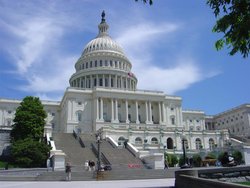
The federal government itself consists of three branches: the executive branch (headed by the President), the legislative branch (the U.S. Congress), and the judicial branch (headed by the Supreme Court). The President is elected to a four-year term by the Electoral College, which is chosen through popular votes in the fifty states and the District of Columbia. The various legislators are chosen by popular vote in the 50 states. Members of Congress are elected for terms of two years in the House of Representatives and six years in the Senate. Justices of the Supreme Court are appointed by the President with the consent of the Senate for an unlimited term. This tripartite model of government is generally duplicated at the state level. Local governments take various forms.
Political Ideology
Though deeply divided along progressive/conservative lines about how structured the ideal moral order should be, the United States is fundamentally a capitalistic society, compared, for example, to the more social democratic political cultures in European democracies. Americans believe that society should primarily reward actions that benefit each member first (and society as a whole synergistically), rather than society as a whole first (and each member eventually).
The ideology and policies of the sitting President of the United States commonly play a large role in determining the direction of his political party, as well as the platform of the opposition.
Political Parties
The federal and state governments are dominated by two major political parties, the Republicans and the Democrats, with the Republican Party being more conservative and the Democratic Party being more progressive. Several other, smaller parties exists as well; but they maintain very few national strongholds.
Political parties in the United States do not have formal "leaders" like many other countries, although there are complex hierarchies within the political parties that form various executive committees. Party ideology remains very individually-driven, with a diverse spectrum of moderates, centrists, and radicals within each party.
The two parties exist on the federal, state, and local levels, although the parties' organization, platform, and ideologies are not necessarily uniform across all levels of government.
Both major parties draw some support from across the diverse socio-economic classes that compose the United States' multi-ethnic society. Business interests provide the bulk of financial support to both parties, generally favoring the Republican party. The Republicans generally receive more funding and support from business groups, religious Christians, and rural Americans, while the Democratic party receives more support from labor unions and minority ethnic groups. Because federal elections in the United States are among the most expensive in the world, access to funds is vital in the political system. Thus corporations, unions, and other organized groups that provide funds and political support to parties and politicians play a very large role in determining political agendas and government decision-making.
Minor party and independent candidates are very occasionally elected, usually to local or state office, but the United States political system has historically supported "catch-all parties" rather than coalition governments.
Foreign relations
- Main article: Foreign relations of the United States
The immense military, economic, and cultural dominance of the United States has made foreign relations an especially important topic in its politics, with considerable concern about the image of the United States throughout the world.
U.S. foreign policy has swung about several times over the course of its history between the poles of isolationism and imperialism and everywhere in between.
As a result of the huge influence, both political and cultural, and the use of the same, the reactions towards the USA are often strong and sometimes irrational, ranging from uninhibited Americophilia and admiration of all things 'American' to Anti-Americanism. A good example is the epithet Ayatollah Khomeini chose to name the United States of America, which is still used today by Iranian officials: The Great Satan.
See also Blowback (intelligence).
Political divisions
Main article: Political divisions of the United States
With the Declaration of Independence, the thirteen colonies transformed themselves into nation states modeled after the European states of the time. In the following years, the number of states within the U.S. grew steadily due to western expansion, the conquest and purchase of lands by the national government, and the subdivision of existing states, resulting in the current total of fifty. The states are generally divided into smaller administrative regions, including counties, cities and townships.
The United States also holds several other territories, districts and possessions, notably the federal district of the District of Columbia, which is the nation's capital, and several overseas insular areas, the most significant of which are Puerto Rico, American Samoa, Guam, Northern Mariana Islands, and the United States Virgin Islands. The United States has held a Naval Base at an occupied portion of Guantanamo Bay, Cuba since 1898. The U.S. government claims a lease to this land, which only mutual agreement or United States abandonment of the area can terminate. The Cuban government disputes this arrangement, claiming Cuba was not truly sovereign at the time of the signing.
The United States has made no territorial claim in Antarctica but has reserved the right to do so.
| Political divisions of the United States |  |
||||||
|---|---|---|---|---|---|---|---|
|
|||||||
Geography
Map of the United States (PDF (http://www.nationalatlas.gov/printable/images/pdf/reference/genref.pdf))
Main article: Geography of the United States
As the world's third largest country (by total area), the United States landscape varies greatly: temperate forestland on the East coast, mangrove in Florida, the Great Plains in the center of the country, the Mississippi-Missouri river system, the Great Lakes which are shared with Canada, Rocky Mountains west of the plains, deserts and temperate coastal zones west of the Rocky Mountains and temperate rain forests in the Pacific Northwest. The volcanic islands of Hawaii and Alaska add to the geographic and climatic diversity.
The climate varies along with the landscape, from tropical in Hawaii and southern Florida to tundra in Alaska and atop some of the highest mountains (even in Hawaii). Most of the North and East experience a temperate continental climate, with warm summers and cold winters. Most of the American South experiences a subtropical humid climate with mild winters and long, hot, humid summers. Rainfall decreases markedly from the humid forests of the Eastern Great Plains to the semiarid shortgrass prairies on the High Plains abutting the Rocky Mountains. Arid deserts, including the Mojave, extend through the lowlands and valleys of the American Southwest from westernmost Texas to California and northward throughout much of Nevada. Some parts of the American West, including San Francisco, California, have a Mediterranean climate. Rain forests line the windward mountains of the Pacific Northwest from Oregon to Alaska.
The political geography is notable as well, with the Canadian border being the longest undefended border in the world, and with the country being divided into three distinct sections: The continental United States, also known as the lower 48; Alaska, which is physically connected only to Canada, and the archipelago of Hawaii in the central Pacific Ocean.
Important cities
Main article: List of cities in the United States
The United States has several dozen major cities. The few which are generally agreed to be world cities are listed below, in order of population:
- New York, New York
- Los Angeles, California
- Chicago, Illinois
- Houston, Texas
- Philadelphia, Pennsylvania
- Dallas, Texas
- San Francisco, California
- Boston, Massachusetts
- Washington, D.C.
- Atlanta, Georgia
- Minneapolis, Minnesota
- Miami, Florida
Economy

Main article: Economy of the United States
The economy of the United States is organized primarily on a capitalist model, with some government regulation in many industries. There are also some social welfare programs like Social Security, unemployment benefits, Temporary Assistance to Needy Families ("welfare"), the Earned Income Tax Credit, Medicare, and Medicaid. Such departures from a pure free-market economy have generally increased since the late 1800s, but are less pronounced in the United States than in other industrialized countries.
Several countries have linked their currency to the dollar (such as the People's Republic of China), or even use it as a currency (such as Ecuador), although this practice has subsided in recent years.
The country has rich mineral resources, with extensive gold, oil, coal, and uranium deposits. Successful farm industries rank the country among the top producers of, among others, corn, wheat, sugar, and tobacco. The U.S. manufacturing sector produces, among other things, cars, airplanes, and electronics. The biggest industry is now service; about three-quarters of U.S. residents are employed in that sector.
The largest trading partner of the United States is its northern neighbor, Canada. Other major partners are Mexico, the European Union, and the industrialized nations in Asia, such as Japan, India, and South Korea. Trade with China is also significant.
In 2002, the United States was ranked as the third most visited tourist destination in the world. Its 41.9 million visits trailed only France (77 million) and Spain (51.7 million).
See also: List of United States companies
Transportation
Main article: Transportation in the United States
To link its vast territories, the United States has built a network of roads, of which the most important aspect is the Interstate highway system. Americans are renowned for their "car-crazy" lifestyle and the sprawling car-oriented design of their cities. The United States also has a transcontinental railroad system which is used for moving freight across the lower 48 states.
Air travel is often preferred for destinations over 300 miles away.
Demographics
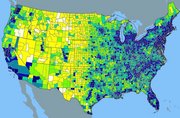
Main article: Demographics of the United States
Ethnicity and race
Americans, in part due to categories decided by the U.S. government, generally describe themselves as being either multi-ethnic or one of five ethnic groups: White, also called Caucasian; African American, also called Black; Hispanic, also called Latino; Asian American, frequently specified as Chinese American,Indian American, Korean American, etc.; and Native American, also called American Indian.
The category Asian is popularly identified with East Asia, rather than Southwest Asia; Pacific Islander/Hawaiian natives, technically Native Americans, may be assigned to Asian-American because of their geographic origins in Oceania; the term African-American is associated with centuries-long residents, and does not make distinctions between them and, say, recent Afro-Caribbean immigrants from Jamaica or refugees from Somalia. Furthermore, the categories disregard the multi-ethnic heritage of many Americans.
The majority of the 290 million people currently living in the United States descend from European immigrants who have arrived since the establishment of the first colonies. Major components of the European segment of the United States population are descended from immigrants from Germany (15.2 percent), Ireland (10.8 percent), England (8.7 percent), Italy (5.6 percent), and Poland (3.2 percent) with many immigrants also coming from Scandinavian or Slavic countries. Other significant immigrant populations came from eastern and southern Europe and French Canada; few immigrants came directly from France. These numbers, however, are inaccurate as many citizens listed themselves as "American" on the census (7.2 percent). A county by county map of plurality ethnic groups (http://www.census.gov/prod/2004pubs/c2kbr-35.pdf.com) reveals that the areas with the largest "American" ancestry populations are historically British-American areas.
Likewise, while there were few immigrants directly from Spain, Hispanics from Mexico and South and Central America are considered the largest minority group in the country, comprising 13.4 percent of the population in 2002. This has brought increasing use of the Spanish language in the United States.
About 12.9 percent (2000 census) of the American people are African Americans, many of whom are descendants of the enslaved Africans brought to the U.S. between the 1620s and 1807. There has been in recent years a large influx of African immigrants to the United States due to the instability in political and economic opportunities in various nations in Africa.
A third significant minority is the Asian American population (4.2 percent), most of whom are concentrated on the West Coast and Hawaii.
The aboriginal population of Native Americans, such as American Indians and Inuit, make up about 1.5 percent of the population.
According to the 2000 census, America has 31 ethnic groups with at least one million people.
See also: Immigration to the United States
Religion
Main Article: Religion in the United States
As of 2004, the distribution for major religions in the United States was as follows: Protestant (54 percent), Roman Catholic (25 percent), "none" (10 percent), Eastern Orthodoxy (3 percent), Mormon (2 percent), Jewish (2-3 percent), Muslim (<2 percent) (See Islam in the United States), and between 0.3 and 0.5 percent each for Buddhist, Hindu and Unitarian Universalist. An additional 0.3 to 0.5 percent, each, are professed agnostics and atheists. The largest single religious denomination in the United States is the Roman Catholic Church, followed by the Southern Baptist Convention, the United Methodist Church and the Latter-Day Saints.
The United States, as a developed nation, is noteworthy for its high level of Christian religious devotion. However, the percentage of Americans calling themselves Christian has declined somewhat in recent years from 86.2 percent in 1990 to 81.0 percent in 2004.
Class
In terms of relative wealth, most U.S. residents enjoy a standard of personal economic wealth that is far greater than that known in most of the world. For example, 51 percent of all households have access to a computer and 67.9 percent of U.S. households owned their dwellings in 2002. However, there is also a considerable amount of poverty in the United States with 12.1% of the population living below the official national poverty level.
The social structure of the United States is somewhat stratified, with a significant class of very wealthy individuals, which are often alleged to hold disproportionate cultural and political influence. However, social mobility is a well-known concept in America, considered part of the "American dream", in that even someone born into a poor family can rise to join the upper classes. The nation's Gini coefficient of 40.8 percent (measuring income inequalities) is the third highest of all developed nations (after South Africa and Mexico).
See also: Richest places in the United States and Poorest places in the United States
Culture
Main article: Culture of the United States

U.S. culture has a large influence on the rest of the world, especially the Western world. This influence is sometimes criticized as cultural imperialism. U.S. music is heard all over the world, and it is the sire of such forms as blues and jazz and had a primary hand in the shaping of modern rock and roll and popular music culture. Many great Western classical musicians and forums find their home in the U.S. New York City is a hub for international operatic and instrumental music as well as the world-famed Broadway plays and musicals. New York and San Francisco are world-wide leaders in graphic design and New York and Los Angeles compete with major European cities in the fashion industry. U.S. movies (primarily embodied in Hollywood) and television shows can be seen almost anywhere. This is in stark contrast to the early days of the republic, when the country was viewed by Europeans as an agricultural backwater with little to offer the culturally "advanced" world centers of Asia and Europe. Nearing the mid-point of its third century of nationhood, the U.S. plays host to the gamut of human intellectual and artistic endeavor in nearly every major city, offering classical and popular music; historical, scientific and art research centers and museums; dance performances, musicals and plays; outdoor art projects and internationally significant architecture. This development is a result of both contributions by private philanthropists and government funding.
Several forms of electronic music originated from the United States. This includes House from Chicago, Techno music from Detroit, and Garage from New York.
The United States is also a great center of higher education, boasting more than 4,000 universities, colleges and other institutions of higher learning, the top tier of which may be considered to be among the most prestigious and advanced in the world.
See also: Arts and entertainment in the United States, Languages in the United States, Education in the United States
Social issues
Main articles: Social issues in the United States, Human rights in the United States, Anti-American sentiment, Health care in the United States
The United States Constitution makes provision for the rights of freedom of speech, the right to keep and bear arms, freedom of religion, trial by jury, and protection from "cruel and unusual punishment." The United States accepts many immigrants and has laws against racial and other forms of discrimination and other protections for minority groups.
Nevertheless, the United States has at times been criticized for violations of human rights, including racial discrimination in trials and sentences, police abuses, excessive and unwarranted incarceration, and the imposition of the death penalty ². In 2001, Human Rights Watch issued a report stating that United States had "made little progress in embracing international human rights standards at home." [1] (http://www.hrw.org/wr2k1/usa/)
As of 2004, the United States has possibly the world's largest prison population at over 2 million inmates; note that the People's Republic of China in particular is suspected of not releasing accurate figures, or of failing to document some prisoners. The International Centre for Prison Studies (http://www.prisonstudies.org/) places the United States' per-capita incarceration rate first in the world, 620% higher than the neighboring country of Canada. Roughly 1 American in 15 will spend time in prison during his or her lifetime [2] (http://www.ojp.usdoj.gov/bjs/crimoff.htm). Some would argue that high incarceration rates reduce criminal offenses, as the crime rate in the United States has been declining for years. Many other countries with lower and/or declining crime rates have a significantly less proportion of their citizens in prison, and some would rebut that such a simple relationship is unlikely.
A disproportionate number of US inmates are black and are significantly over-represented when compared to the national population [3] (http://www.infoplease.com/ipa/A0903755.html). The discrepancy is a 285%* difference between the national population and the inmate population. (*2000 Population by race [4] (http://www.census.gov/prod/3/98pubs/p23-194.pdf), 1997 Inmate population by race [5] (http://www.ojp.usdoj.gov/bjs/glance/tables/cpracetab.htm)). For admissions into the system, a black male is, on average, 8-10 times more likely than a white male to be sent to prison for drug offenses, and, in the state with the largest discrepancy, Illinois, 57 times more likely [6] (http://www.hrw.org/reports/2000/usa/Rcedrg00-04.htm).
The United States is one of the largest industrialized nations in the world without a nationalized healthcare system. At present, more than 40 million Americans are not covered by health insurance.
The United States' suicide rate exceeds its homicide rate, but is still lower than most other industrialized nations.
Routine infant male circumcision is legal and widely practiced, despite ongoing efforts by the American Academy of Pediatrics to persuade the public to abandon the practice.
A number of American-based corporations, perhaps most visibly McDonald's, Coca-Cola, Wal-Mart, and Disney, have spread to many other countries, some of which have displayed resentment at the spread of American culture. McDonald's particularly has been the subject of protest and even acts of vandalism.
Despite having only 5% of the world's population, the United States consumes 25% of the world's power. [7] (http://www.nationmaster.com/graph-T/ene_ele_con) In terms of per capita usage, the U.S. ranks ninth.
Partly because of the United States' status as one of the world's most powerful nations, the English language has also spread worldwide. The concern that English is rapidly displacing other languages is widespread. Likewise, speakers of other dialects of English (for example in Britain and Australia) feel that their language is becoming "Americanized."
Federal holidays
Main article: Holidays of the United States
| Date | Name | Remarks |
|---|---|---|
| January 1 | New Year's Day | Beginning of year, marks traditional end of "holiday season" |
| January, third Monday | Martin Luther King, Jr. Day | Honors late Dr. King, Civil Rights leader |
| February, third Monday | Presidents' Day | Honors former U.S. Presidents, especially Washington and Lincoln |
| May, last Monday | Memorial Day | Honors servicemen and women who died in service, marks traditional beginning of summer |
| July 4 | Independence Day | Celebrates Declaration of Independence, usually called the Fourth of July |
| September, first Monday | Labor Day | Celebrates achievements of workers, marks traditional end of summer. This holiday is held instead of the traditional worldwide Labor Day, May 1, which actually began in the U.S. |
| October, second Monday | Columbus Day | Honors Christopher Columbus, traditional discoverer of the Americas |
| November 11 | Veterans' Day | Honors those who have served in the military. Also marks the end of WWI in 1918. (Previously known as Armistice Day.) Traditional observation of a moment of silence at 11 a.m. in remembrance of military service members |
| November, fourth Thursday | Thanksgiving | Day of thanks that marks the traditional beginning of the "holiday season" |
| December 25 | Christmas | Celebrates the nativity of Jesus, also celebrated as secular winter holiday |
Related topics
Main article: List of United States-related topics
International rankings
- IMD International: World Competitiveness Yearbook 2004 (http://www01.imd.ch/wcy/), ranked 1 out of 60 economies (countries and regions)
- World Economic Forum: Global Competitiveness Report 2004-2005 - Growth Competitiveness Index Ranking (http://www.weforum.org/site/homepublic.nsf/Content/Global+Competitiveness+Programme%5CGlobal+Competitiveness+Report), ranked 2 out of 104 countries
- UNDP: Human Development Index 2004 (http://hdr.undp.org/reports/global/2004/), ranked 8 out of 177 countries
- Save the Children: State of the World’s Mothers 2004 (http://www.savethechildren.org/mothers/report_2004/images/pdf/SOWM_2004_final.pdf), ranked 10 out of 119 countries
- Heritage Foundation/The Wall Street Journal: 2005 Index of Economic Freedom (http://www.heritage.org/research/features/index/), ranked 12 out of 155 countries
- Transparency International: Corruption Perceptions Index 2004 (http://www.transparency.org/pressreleases_archive/2004/2004.10.20.cpi.en.html), ranked 17 out of 146 countries (tied with Belgium and Ireland)
- Reporters without borders: Third annual worldwide press freedom index (2004) (http://www.rsf.fr/article.php3?id_article=11715), ranked 22 (American territory; tied with Belgium) & 108 (in Iraq) out of 167 countries
Notes
¹ In the English-speaking world, America has become synonymous with the nation of the United States while American refers to United States (U.S.) citizens; this is a standard usage in not only
the U.S. itself, but also much of Europe and Australasia. The term Americas, on the other hand, includes the North and
South American continents as a collective unit. In Spanish-speaking countries, particularly in Central and South America, the
word América is used not to denote the U.S. but all residents of North and South America. Thus, some people of the
Americas find it off-putting for the U.S. to be referred to as America and inhabitants of the U.S. as Americans. In
some quarters, the accuracy and political correctness of such nomenclature is debated.
²The death penalty is only carried out in some U.S. states and it is in itself a controversial issue within the U.S. See:
Human rights in the
United States
External links
United States government
- Official website of the United States government (http://www.firstgov.gov) - Gateway to governmental sites
- White House (http://www.whitehouse.gov) - Official site of the US President
- Senate.gov (http://www.senate.gov) - Official site of the United States Senate
- House.gov (http://www.house.gov) - Official site of the United States House of Representatives
- SCOTUS (http://www.supremecourtus.gov) - Official site of the Supreme Court of the United States
- Portrait of the USA (http://usinfo.state.gov/usa/infousa/facts/factover/homepage.htm) - Published by the United States Information Agency, September 1997.
- US Census Housing and Economic Statistics (http://www.census.gov/hhes/www/) Updated regularly by US Bureau of the Census.
- National Atlas (http://nationalatlas.gov/)
- CIA World Factbook Entry for United States (http://www.cia.gov/cia/publications/factbook/geos/us.html)
Other
- US Newspapers by State (http://www.mediatico.com/en)
- National Motto: History and Constitutionality (http://www.religioustolerance.org/nat_mott.htm)
- Historical Documents (http://www.nationalcenter.org/HistoricalDocuments.html)
- Reference: US specific web resources sorted by state (http://www.travel-directory.org/Destinations/North_America/United_States/index.html)
- info links for each state (http://www.teacheroz.com/states.htm)
| Countries in North America |
|---|
| Antigua and Barbuda | Bahamas | Barbados | Belize | Canada | Costa Rica | Cuba | Dominica | Dominican Republic | El Salvador | Grenada | Guatemala | Haiti | Honduras | Jamaica | Mexico | Nicaragua | Panama | Saint Kitts and Nevis | Saint Lucia | Saint Vincent and the Grenadines | Trinidad and Tobago | United States |
| Dependencies: Anguilla | Aruba | Bermuda | Cayman Islands | Greenland | Guadeloupe | Martinique | Montserrat | Navassa Island | Netherlands Antilles | Puerto Rico | Saint-Pierre and Miquelon | Turks and Caicos Islands | U.S. Virgin Islands | British Virgin Islands |

